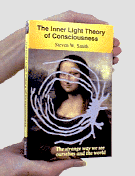| The
Inner Light Theory
of Consciousness by Steven W. Smith, Ph.D.
ISBN 0-9660176-1-7 (2001) |
 |
| The
Inner Light Theory
of Consciousness by Steven W. Smith, Ph.D.
ISBN 0-9660176-1-7 (2001) |
 |
A Brief Overview
|
Look around and concentrate on what you experience. Perhaps it is a warm
summer day and you are sitting on an outdoor patio. You see a deep
blue sky and smell the fragrance of the flowers in bloom. Wind blowing
through the branches of a nearby tree provides a soothing melody.
You feel the texture of these papers in your hands, and can still taste
the last sip of your beverage. Of course, your experience will be
different; you may be in a university library, at your desk at work, or
relaxing on the couch in your home. You may be smelling the fragrance
of flowers, the sweetness of newly baked cookies, or the lingering odor
of disinfectant. You undoubtedly will be experiencing many things
from your five senses, plus an introspective view of your mind's operation.
These are the things you perceive, and are therefore the things that define
your reality.
But now imagine that you suddenly awake and realize it was only a dream. The things you had been experiencing can now be seen from an enlightened perspective. Before you awoke, you justifiably believed that the sights and sounds you experienced were genuine, originating in an external physical universe. The tree, papers, and patio seemed more that just your perception of them; they were real objects with an independent existence. Or so you thought. But now that you are awake you have gained a greater knowledge, the knowledge that your previous reality was not genuine. The things that you had been perceiving exist only in your mind, and nowhere else. The lesson here is extraordinary: the low-level activity of the brain is capable of placing its high-level activity into an artificial reality. We know this for a fact; it is clearly demonstrated to us each night as we dream. It is undeniable that the machinery to accomplish this feat is present in each and every human brain. The nature and extent of this "subreality machine" remains for us to determine; but one fact is indisputable, it is there. The Inner Light theory takes this a step farther, asserting that this "subreality machine" is also activated during our waking hours, just as during our dreams. The unconscious processes that create our dream reality, also create our waking reality. This is not to suggest that the external physical world is an illusion. On the contrary, when we are awake and perceive an apple, we have every reason to believe that the universe contains such an object. However, we do not, and cannot, experience the physical apple directly. The best we can do is to capture clues about the object's nature. These clues come in the form of light photons, sound waves, molecules of various chemicals, and mechanical interactions. These are the physical principles that underlie our five senses, resulting in neural signals being sent to our brains. These indirect clues are all we know about the physical universe, and the only things we can know about it. But of course, our conscious perception of an apple is nothing like photons, sound waves, or neural activity. We see an apple as red, feel it as smooth, and taste it as sweet. This is our introspective experience, because this is the representation that the subreality machine has created for us. Our unconscious mental processes fused the multitude of sensory data into the thing we recognize as an apple. Everything that we are conscious of has been created in this way. Our consciousness exists in this inner reality, not the physical world. When we are awake, the inner reality is constructed to mimic our external surroundings. When we dream, the inner reality exists on its own, without regard for anything outside of our brains. But either way, all we can consciously experience is the inner reality created for us by the subreality machine in the brain. In groundbreaking work, The Inner Light Theory of Consciousness explores the evidence for this remarkable claim, from the structure of the brain, to the very way we perceive ourselves and the world around us. Read the longer
overview
(12 pages)
|
 |
copyright © 2001 by California Technical Publishing |